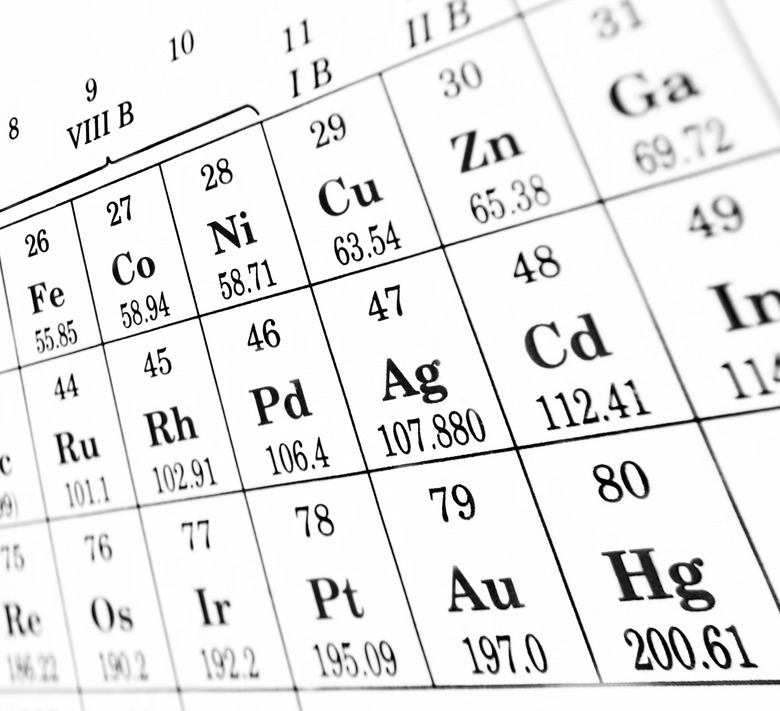How To Figure Valence Of Electrons In The Periodic Table
Electrons orbit around the nucleus of an atom at set energy levels known as principal energy levels, or electron shells. Each electron shell is composed of one or more subshells. By definition, valence electrons travel in the subshell farthest away from the nucleus of the atom. Atoms tend to accept or lose electrons if doing so will result in a full outer shell. Accordingly, valence electrons directly influence how elements behave in a chemical reaction.
Finding Valence Electrons for All Elements Except Transition Metals
Step 1
Locate the desired element on the periodic table. Each square on the periodic table contains the letter symbol for an element printed directly below the atomic number of the element.
For example, locate the element oxygen on the table. Oxygen is represented by the symbol "O" and has an atomic number of 8.
Step 2
Determine the group number and period number of the element. The vertical columns of the periodic table, counting left to right, 1 through 18, are called groups. In the periodic table, elements with similar chemical properties are in the same group. The horizontal rows of the periodic table, from 1 to 7, are called periods. Periods correspond to the number of electron shells possessed by atoms of the elements in that row.
Oxygen is found in Period 2, Group 16.
Step 3
Apply the rule of the periodic table to your element. The rule is as follows: If an element is not a transition metal, then valence electrons increase in number as you count groups left to right, along a period. Each new period begins with one valence electron. Exclude groups 3 through 12. These are transitional metals, which have special circumstances.
Following this rule: Elements in group 1 have one valence electron; elements in group 2 have two valence electrons; elements in group 13 have three valence electrons; elements in group 14 have four valence electrons; and so forth up to group 18. elements in group 18 have eight valence electrons, except for helium, which has only two.
Oxygen is located in group 16 on the periodic table, so it has six valence electrons.
Finding Valence Electrons for Transition Metals
Step 1
Be aware of the unique electron configuration of transition metals.
Valence electrons are generally what is left over after all the inner subshells of an atom have been filled. However, transitional metals may have subshells that are not completely filled. An atom may tend to accept or lose electrons from an incomplete subshell if doing so will result in a full subshell, so subshell electrons may behave like valence electrons. By strict definition, most transitional metals have two valence electrons, but may have a larger range of apparent valence electrons.
Step 2
Locate the transition metal on the periodic table and make note of the group number. Use iron as an example, a transitional metal with the symbol Fe, atomic number 26 , located at period 4, group 8.
Step 3
Determine the range of apparent valence electrons.by consulting the following table:
Group 3: 3 valence electrons Group 4: 2-4 valence electrons Group 5: 2-5 valence electrons Group 6: 2-6 valence electrons Group 7: 2-7 valence electrons Group 8: 2-3 valence electrons Group 9: 2-3 valence electrons Group 10: 2-3 valence electrons Group 11: 1-2 valence electrons Group 12: 2 valence electrons
The element iron is in group 8, and therefore has two or three apparent valence electrons.
TL;DR (Too Long; Didn't Read)
Electron shells are labeled K, L, M, N, O, P, and Q or simply 1 to 7; starting with the shell closest to the nucleus and moving out. Each electron shell can hold a fixed, maximum number of electrons: the K shell holds a maximum of two electrons, the L shell holds eight electrons, the M shell holds eighteen electrons and the N shell holds a maximum of thirty-two electrons. Theoretically, the O Shell could contain fifty electrons and the P shell could contain seventy-two electrons, but no naturally occurring element has more than thirty-two electrons in any single shell.
The maximum number of valence electrons for an atom is eight.
There are two lines of elements listed below the main table on the periodic chart, the lanthanides and actinides. All lanthanides belong in Period 6, Group 3. Actinides belong in Period 7, Group 3. These elements are known as inner transition metals.
Cite This Article
MLA
Jacobson, Emily. "How To Figure Valence Of Electrons In The Periodic Table" sciencing.com, https://www.sciencing.com/figure-valence-electrons-periodic-table-5847756/. 27 April 2018.
APA
Jacobson, Emily. (2018, April 27). How To Figure Valence Of Electrons In The Periodic Table. sciencing.com. Retrieved from https://www.sciencing.com/figure-valence-electrons-periodic-table-5847756/
Chicago
Jacobson, Emily. How To Figure Valence Of Electrons In The Periodic Table last modified March 24, 2022. https://www.sciencing.com/figure-valence-electrons-periodic-table-5847756/


